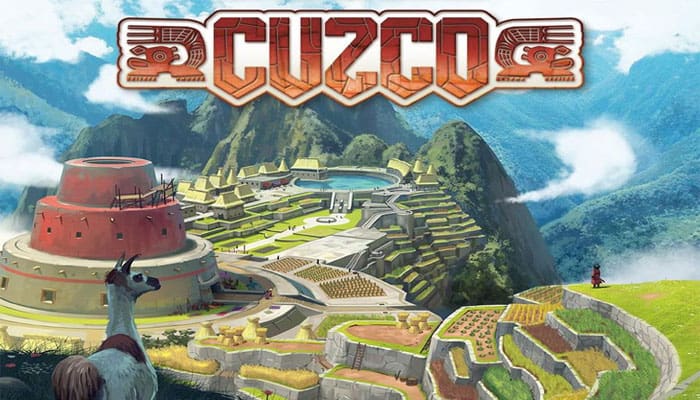
Components
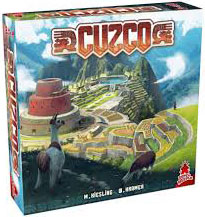
- 1 Gameboard
- 48 Inca meeples
- 4 Prestige markers
- 56 Triple Terrains
- 20 Double Terrains
- 12 "Crop" single Terrains
- 8 "Village/City"single Terrains
- 19 Irrigation Ponds
- 15 Solar Discs
- 12 "Additional Action" tokens
- 47 Temple floors
- 30 Festival cards
- 4 Double-sided player aids
Setup
The first time you play, carefully detach all of the cardboard Terrains and tokens.
Place the gameboard in the middle of the table. The central portion represents the Cuzco site; it comprises 150 empty hexes and 3 Irrigation Pond hexes. Cuzco is entirely surrounded, half by forest, and half by mountain.
Each player chooses a color and places the Prestige marker of that color on space 0 of the Score Track that circles the board.
Place the triple Terrains, the Irrigation Ponds, the Solar Discs, and the Temple floors (according to their value) beside the board.
Place 1 Irrigation Pond on each of the 3 Ponds printed on the gameboard.
Shuffle the Festival cards and place them face down beside the board to form the deck, then flip the 1st card and place it face up beside the deck to form the discard.
Each player receives:
- 12 Inca meeples of their color
- 3 Additional Action tokens
- 5 double Terrains.
- 2 Village/City single Terrains, 3 Crop single Terrains.
- 3 Festival cards from the deck (keep them secret).
- 1 double-sided Player Aid.
For a 2- or 3-player game, leave everything else in the box (including the other single and double Terrains, but not the Ponds!).
Game Play
Randomly determine the first player. You will take turns in clockwise order. On your turn, you must place at least one Terrain. This may enlarge or reduce the sizes of Villages, Cities, and Crops already placed.
Then you can place other Terrains, bring your Incas into and out of the Cuzco site or move them within it, build or expand Temples, set up Irrigation Ponds, and propose organizing a Festival.
Each of these actions (including the mandatory placement of Terrain at the beginning of your turn) costs a certain number of the 6 Action Points (AP) at your disposal each turn (any Action Points you do not use are wasted).
In a single turn, you can repeat an action as many times as you wish (as long as the rules allow it) and performyour your actions in any order; however, you must start by placing a Terrain, and you can only propose organizing a Festival at the end of your turn.
The player(s) who play the most Festival Points (FP), by discarding cards depicting the required Relics, will organize the Festival. Certain actions immediately earn you Prestige Points (PP), which will advance your Prestige marker on the Score Track.
However, you will score most of your PP in the Grand Final Scoring.

Additional Action Tokens
Each player has 3 Additional Action tokens. You can use 1 of your tokens to have 7 AP on your turn instead of just 6 AP. When you do this, remove the token from the game. You can only use 1 token per turn.
-
Place a Terrain on the board. (1 AP)

You are required to place at least 1 Terrain (at the beginning of your turn), regardless of whether it is single, double, or triple.
-
Bring an Inca into the Cuzco site through the forest, or take one out through the forest. (1 AP)

An Inca can only enter or leave through a Terrain (Crop or Village/City) placed along the forest edge of the site. An Inca can neither enter nor leave through an empty hex on the gameboard.
-
Bring an Inca into the Cuzco site through the mountains, or take one out through the mountains. (2 AP)

An Inca can only enter or leave through a Terrain (Crop or Village/City) placed along the mountain edge of the site. An Inca can neither enter nor leave through an empty hex on the gameboard.
-
Bring an Inca into the Cuzco site through the mountains, or take one out through the mountains. (0 AP)

Moving an Inca from hex to hex is free as long as the Inca stays on the same type of Terrain, no matter how far the Inca moves, no matter how many times the Inca climbs up or down.
-
Move an Inca any number of Terrain hexes of a single type. (1 AP)

Moving an Inca from a Crop hex to a Village/City hex or vice versa (regardless of whether the Inca climbs up or down) costs 1 AP.
-
Build a Temple. (1 AP)

On your turn, you can build Temples in several Villages. The value of each Temple built cannot exceed the number of hexes composing the Village.
PP equal to half the value of the Temple.
-
Expand a Temple. (1 AP)

On your turn, you can expand several Temples, but you cannot expand a single Temple more than once in the same turn (the value of the expanded Temple cannot exceed the number of hexes composing the City that contains the Temple) /PP equal to half the new value of the Temple
-
Build an Irrigation Pond. (1 AP)

Ponds must be placed directly on empty hexes of the board (not on a Terrain). You can place several in the same turn.
3 PP per Pond tile when entirely surrounded by Terrain tiles (for the adjacent Inca at the highest elevation).
-
Draw 1 or 2 Festival cards. (1 AP/2 AP)

You cannot draw more than 2 Festival cards per turn.
-
Organize a Festival in a Temple. (0 AP)

You can propose organizing only 1 Festival per turn (and only at the end of your turn). You must have at least 1 Inca in the City
1 to 5 PP (for the organizers, which are the players who bring the most of the required Relics).
The Actions in Detail
Placing a Terrain

You must begin your turn by choosing a single, double, or triple Terrain tile (singles and doubles come from your personal supply; triples come from the common supply). For 1 Action Point (1 AP), you must place it either directly on the Cuzco site (gameboard) or atop Terrains already in play, respecting the following rules:
You can place a Terrain on whichever hex(es) you wish; however, you cannot cover a Pond or a hex with an Inca or a Temple in it.
This Terrain does not need to be placed adjacent to another Terrain already on the board.
This Terrain does not need to be placed adjacent to the forest or mountain border of the Cuzco site
It is possible to form Terraces out of the Terrains by superimposing them. You can place this Terrain atop other Terrains under the following conditions:
- No part of this Terrain can be hanging over empty air
- This Terrain cannot be stacked perfectly atop a Terrain of the same shape.
- You cannot merge two Cities by placing a Village/City Terrain; however, you can link a City and a Village to expand the City (the presence of a Temple transforms a Village into a City; see "Building or Expanding a Temple").
A double or triple Terrain can overflow the hexes of the Cuzco site under the following conditions:
- It must cover at least 1 hex of the Cuzco site.
- Each hex of the Terrain that overflows the Cuzco site costs an additional 1 AP.
Important: Although the overflow placement rule can be used at any time, it is especially useful toward the end of the game, when it becomes difficult to place a Terrain. Placing Terrain atop Terrains that are already overflowing does not require additional AP.
In addition to the mandatory first placement, you are welcome to place one or more other Terrains at any time on your turn, as long as you have enough AP to do so.
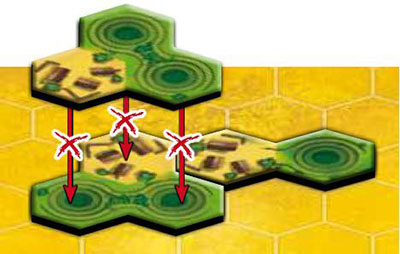 Terrain cannot be stacked perfectly atop a Terrain of the same size |
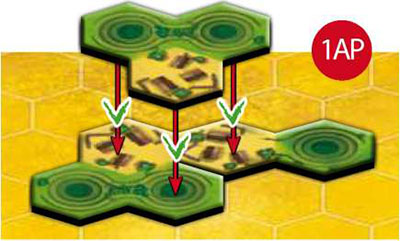
Moving Incas
You can move Incas as follows:
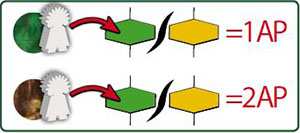
An Inca at the border of the Cuzco site can enter play in, or leave from any Crop or Village/City hex along that border. Entering or leaving through the forest costs 1 AP; through the mountain costs 2 AP.

Incas can move for free as many hexes as you wish on the same type of Terrain (even if they climb up or down the Terraces); this costs 0 AP.

Each move that results in changing Terrain type (Crop to Village/City, or vice versa) costs 1 AP. Incas can only move on Terrains, never on empty hexes, Temples, or Ponds.
There can be no more than one Inca on each Terrain hex. Incas cannot traverse hexes containing enemy Incas; however, they can traverse hexes containing Incas of their own color.
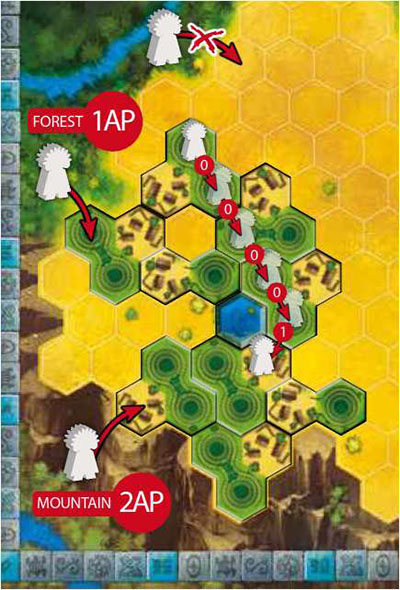 Incas enter and leave Cuzco through Terrain hexes adjacent to the border; this costs 1 AP through the forest, 2 AP through the mountains |
Building or expanding a Temple
Building or expanding a Temple earns you Prestige Points (PP).

Building a Temple costs 1 AP. Expanding a Temple costs 1 AP. Anyone can expand Temples (not just the player who built them) to earn PP
Only the player who occupies the highest position in the Village is allowed to build a Temple, and only the player who occupies the highest position in the City is allowed to expand the Temple.
You occupy the highest position in the Village/City when you have more Incas at the highest elevation in theVillage/ City than anyone else. If there is a tie, compare your second-highest Incas. If still tied, compare your third-highest, etc.
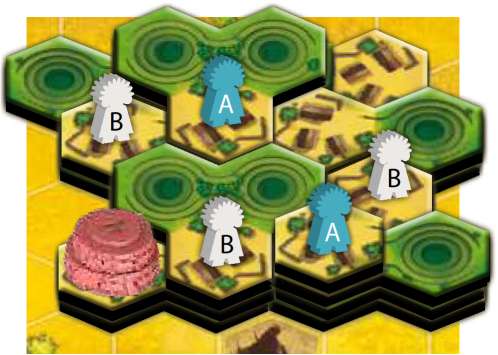 Player A has the Inca at the highest elevation (level 4) in the City. Thus, player A is allowed to expand the Temple, even though player B has 3 Incas in the City |
Important : If nobody occupies the highest position, nobody can build or expand a Temple. Being tied is not sufficient!
A Temple can only be built on an empty Village hex (with no Inca in it). The elevation of the hex does not matter. The presence of a Temple transforms the Village into a City.
A City can only have one Temple. A Temple cannot be expanded beyond value 10 (this is the highest floor available). When you build/expand a Temple, its value must be less than or equal to the number of hexes composing the Village/City.
Thus, you can build a value-2 Temple in a 2- or 3-hex Village, you can build/ expand to a value-4 Temple in a 4- or 5-hex Village/City, you can build / expand to a value-6 Temple in a 6- or 7- hex Village/City, etc. The hex on which the Temple stands still counts as part of the City.
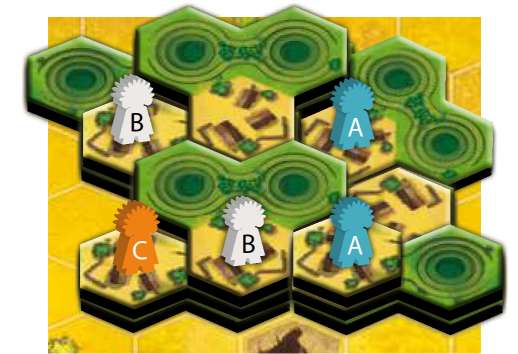 Players A and B both have an Inca at level 3. But player B's second Inca is at level 2, while player A's is at level 1. Only player B can build a Temple in the Village. Player C is ignored, because C has no Inca at level 3. |
Important : A Temple does not have to start at value 2. Its value could be higher if the Village already comprises enough hexes. For example, if the Village is already 4 or 5 hexes, you could directly build a value-4 Temple (by stacking a value-4 floor atop a value-2 floor right away), which still costs only 1 AP.
In the same way, a Temple can be upgraded directly from 4 to 8 if the City comprises 8 or 9 hexes (including the Temple), by adding both floors 6 and 8 for a total of only 1 AP.
When you expand a Temple, stack the new floor(s) atop the existing one(s). They cannot be removed. You cannot connect two Cities; however, you can connect a City to one or more Villages, making it possible to expand the Temple.
A single Temple can only change value once per turn: You can neither build a Temple and then expand it in the same turn, nor expand a Temple multiple times in the same turn. On the other hand, if you occupy the highest position in several Villages/Cities, and you have enough AP, you can build/expand several Temples (only once each!) in several Villages/Cities in the same turn.
When you build or expand a Temple, immediately advance your Prestige marker half the new value of the Temple on the Score Track.
Important: A Temple makes the hex on which it is built holy. Incas can no longer traverse (nor stop on) that hex.
Important: When you are covering hexes while superimposing Terrains, it is possible that you shrink a City or cut it in two. This does not change the value of its Temple. If the City is cut, the part without a Temple once again becomes a Village, which can accommodate a new Temple.
Setting Up an Irrigation Pond

Ponds only earn PP if they are completely surrounded by Terrain tiles.
When you take a Pond from the general supply for 1 AP, you must place it directly on an empty hex of the board, never on a Terrain.
You cannot place a Pond along the borders of Cuzco. You can place a Pond adjacent to another to form a larger Pond.
As soon as a Pond (comprising one or more adjacent Pond tiles) is entirely surrounded by Terrain tiles, immediately check who occupies the highest position on the Terrain hexes directly adjacent to the Pond (regardless of whether they are on Crops, Villages, or Cities); the ranking and tiebreaker rules are the same as in "Building or Expanding a Temple". For each hex of the Pond, that player immediately earns 3 PP
If no one occupies a higher position than the others (perfect tie, or there are no Incas around the Pond), nobody earns PP for this Pond.
If a single empty hex between Terrains remains on the board, you are still welcome to set up a Pond in it for 1 AP. Because it is already surrounded, award the PP immediately, as explained above.
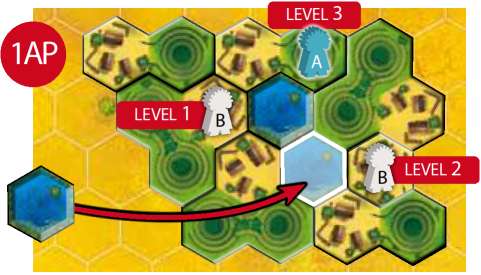 A player places an Irrigation Pond tile on a completely surrounded empty hex, creating an entirely surrounded 2-hex Pond. Player A is on level 3 beside the Pond, while both of player A's Incas are lower; so, player A immediately gains 6 PP (3 PP per hex in the Pond). |
Drawing Festival Cards

You may draw a maximum of 2 Festival cards on your turn for 1 AP each. For each draw, choose one of the following:
the face-up Festival card, which is immediately replaced by the top card of the deck (even if there are still cards in the discard).
the top face-down Festival card from the deck.
Keep your cards secret from the other players.
Organizing A Festival

At the end of your turn, if you wish, for 0 AP you can propose organizing a Festival in a City in which you have at least one Inca.
The other players who have Incas in the City can decide to participate in the Festival. The interested players will compete with their Festival cards, each of which depicts 1 or 2 Relics.
The face-up Festival card on top of the discard indicates the type(s) of Relic you must present to participate:
- If the face-up card depicts 1 Relic, each player can play cards that depict this Relic
- If the face-up card depicts 2 Relics, each player can play cards that depict one or both of these Relics
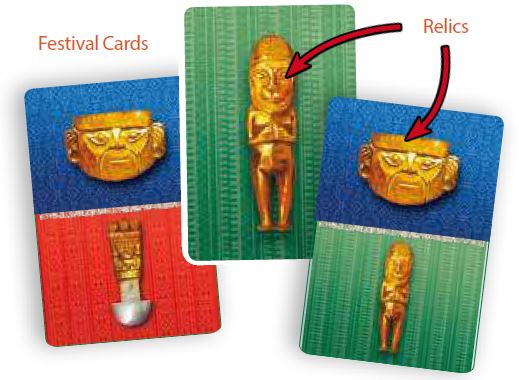
Other Relics depicted on the cards you play do not count. Each Relic matching the face-up card on top of the discard is worth 1 Festival Point (FP).
Because you proposed organizing the Festival, you are first to play one or more appropriate Festival cards face-up in front of you. There are two possibilities:
-
No one else plays any cards. In this case, you organize the Festival alone, and immediately score the PP corresponding to the Temple size (see the£"y column on the back of the Player Aid)
-
Other players (in turn order) also play cards, each playing cards with total FP greater than or equal to the highest bid so far. After a complete round of bidding, each player may increase their total FP bid or drop out of the competition. This continues until one of the following is true:
Only one player remains, with the highest bid. This player organizes the Festival alone, and immediately scores the PP corresponding to the Temple size (see the
 column on the back of the Player Aid).
column on the back of the Player Aid).All of the remaining participants agree to co-organize. Each player immediately scores the PP corresponding to the Temple size
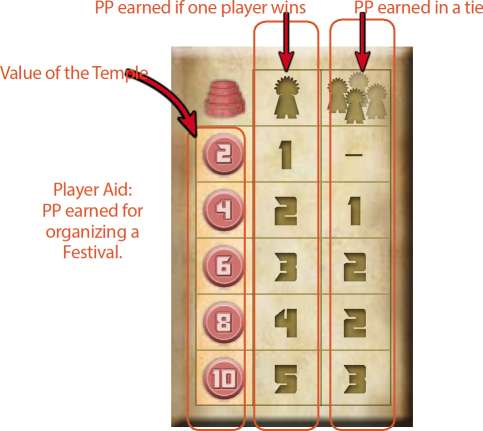
If there is a tie, and none of the participants can play another Festival card, the agreement is automatic.
All cards the participants played are discarded, even if they dropped out of the bidding early. Place these cards face up on the discard beside the deck. Flip the top card of the deck face up atop the discard to indicate the Relic(s) required for the next Festival.
After the Festival has been organized (and the organizers have scored their PP), place a Solar Disc atop the Temple to indicate that no new Festival can be organized there until the Temple has been expanded again. When the Temple is expanded, immediately remove the Solar Disc.
Important : You are not required to have built or expanded the City's Temple in order to participate in the Festival. You merely must have an Inca in the City.
End of the Game
If you place the final triple Terrain, then finish your turn, and perform your Grand Final Scoring. Then, each player plays their final turn, during which they are no longer required to place a Terrain, and then performs their own Grand Final Scoring.
For your Grand Final Scoring, proceed Temple by Temple. For each Temple, you score PP if you hold 1st or 2nd position in the City:
-
If one of your Incas occupies the highest position in the City, that is, if one of your Incas is at a higher elevation than all opponents' Incas there, you score PP equal to the value of the Temple.
-
If you are at the same elevation as an opponent's Inca, compare your second Incas in the City, and so on (see the rules in "Building or Expanding a Temple"). If you are perfectly tied for first place, you still score the entire PP of the Temple's value.
-
If your Inca is second place in the City, you score PP equal to half the value of the Temple. The same tiebreakers apply as for first place. If you are tied for second place, you still score half the Temple's value.
Example : In a City with a value-10 Temple, players A, B, and C each have an Inca at level 3 and an Inca at level 2. Player B has another Inca at level 1, but the others do not.
So, he holds 1 st place and scores 10 PP. If nothing else changes by the ends of their turns, players A and C will be tied for 2nd place, and each will score 5 PP during their Grand Final Scoring.
Player C may very well use her final turn to move an Inca to seize 1 st place in this City, so she can score 10 PP
To indicate that you have already scored your PP for a Temple, lay your Incas in the City down. This ensures that you won't forget a Temple and that you won't score one twice
Even after you have performed your own Grand Final Scoring, you can still participate in organizing a Festival and thus still score PP.
After each player in turn has completed their Grand Final Scoring, the game is over.
The player with the most Prestige Points on the Score Track wins, and becomes the new Emperor.
If it is a tie, you share the throne.
Tip: Over the course of the game, never lose sight of your Grand Final Scoring. Make sure that, early enough, you occupy the highest level in as many Cities as possible.
You must also manage your supply of single and double Terrains, because these can be decisive in the final round, just before your Grand Final Scoring.
Attention: If you wish to build or expand a Temple, but there are no more of the floor of the necessary value, you cannot perform that action.
Glossary
Glossary
AP = Action Points (player actions).
FP = Festival Points (total number of Relics).
PP = Prestige Points (score track).
Continue Reading
